North American Outlook
North American offshore rig count declining in a boom market
Working rigs off slightly, but inventory is moving to richer markets.
Tom Marsh, Vice President, ODS-Petrodata
Record oil prices have boosted worldwide offshore rig demand to its highest level in years, yet the working rig counts in the US Gulf of Mexico and off Canada’s Atlantic provinces are on the decline.
THE GULF
In July 2005, before two devastating hurricanes struck the US Gulf coast, 120 mobile offshore rigs were working. One year later, only 109 mobile offshore rigs are working in the region, and while last year’s storms get some of the blame for the decline, they are not the sole reason for the falling US Gulf rig count. As can be seen in Fig. 1, a long-term decline in rig supply has been taking place, unrelated to hurricanes. The more-or-less steady decline in the US Gulf rig fleet size is indicative of market forces at work. For many years, the region was, and for the most part continues to be, a well-to-well market in terms of drilling contracts. This is a direct result of the makeup of the companies that now drill in US Gulf waters: Of the 109 rigs working in the area in July 2006, 77 were drilling for independent operators. In addition, almost half of all US Gulf drilling contracts are now short-term, that is, for four or fewer wells.
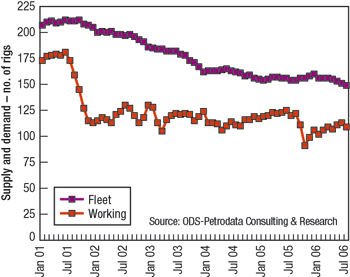 |
Fig. 1. US Gulf MODU supply and demand.
|
|
Rig owners with the right equipment and the wherewithal to do so have taken advantage of strong rig demand in international markets and moved their rigs to "greener" seas, where contracts provide longer, firm terms and profitable day rates. Since January 2005, 22 rigs have left US waters for other markets, and ODS-Petrodata has identified another 17 rigs that are likely to leave the region over the next 12 months.
Rig owners emerge as the winners in this exodus, while US Gulf operators and, over the longer term, other regional service and supply companies are the losers. Owners are enjoying strong day rates worldwide, and these obviously come at the expense of their customers, the oil companies. Figures 2 and 3 illustrate average day rates for selected Gulf of Mexico rig classes. The pattern is essentially the same in most rig market categories, with a significant increase in rates having reached a peak and then pulled back somewhat to a level that should be sustainable until this rig market cycle begins to wind down. This particular offshore rig market cycle will be stronger and longer than other recent market cycles, as it is driven primarily by rising global demand for energy rather than commodity price fluctuations resulting from geopolitical issues.
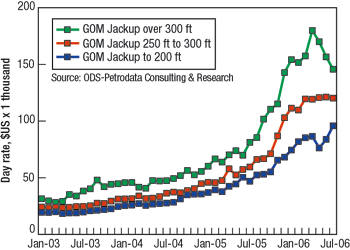 |
Fig. 2. Average Jackup day rates – selected jackup classes.
|
|
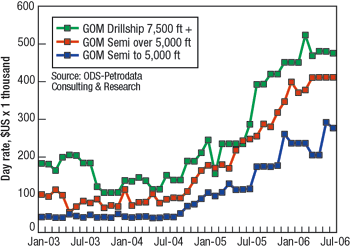 |
Fig. 3. Average MODU day rates – selected floating rig classes.
|
|
The pattern is the same in most rig market categories, with a significant increase in rates having reached a plateau that should be sustainable throughout much of the current market cycle. This particular offshore rig market cycle will be stronger and longer than other recent market cycles, as it is driven primarily by rising global demand for energy rather than commodity price fluctuations resulting from geopolitical issues.
In other times, a slide in the US Gulf working offshore rig count, such as the one that seems likely over the coming months, would be viewed as disastrous by rig owners, but as this slide results from rigs moving to other markets to work under long-term contracts at attractive rates, rig owners are a happy lot.
However, US Gulf operators will find it increasingly difficult to secure equipment for their drilling programs, and the decline in the number of working rigs inevitably affects other industry segments, from support vessel owners to caterers. In an ironic twist, last year’s hurricanes will compensate for the falling rig count for many companies that offer maintenance, repair and other services needed in the wake of the storms, but over the longer term, a lower working rig count will mean less work for all.
ODS-Petrodata forecasts that rig demand in the region will continue to rise (Fig. 4), and this is the challenge operators face. Based on surveys of operators’ drilling plans conducted by the firm, US Gulf rig demand would exceed 125 rigs in first quarter 2007 if rigs were available. However, rig supply will be insufficient to meet demand. The result will be continued high day rates, and delayed or cancelled drilling programs.
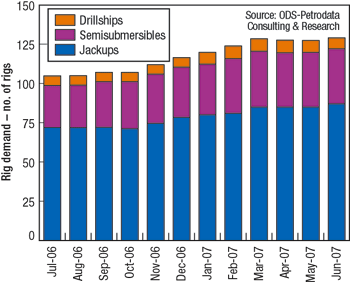 |
Fig. 4. US Gulf offshore rig demand forecast.
|
|
ALASKAN ODDITY
Alaska will see its first active mobile offshore drilling rig in several years (and its first non-Arctic class rig since 1994) when the jackup Songa Tellus arrives in the northernmost US state to drill in the Cook Inlet basin. The rig, which is being refurbished in a Texas shipyard, will mobilize to Alaska in December. Drilling is expected to begin on Houston-based Escopeta Oil & Gas’ East Kitchen prospect by March 2007. ASRC Energy will manage the rig. Unfortunately, this is not a trend. No other operators are known to have a need for mobile drilling units for work in Alaskan waters.
CANADA WANES
The Canadian offshore rig market is poised to go nowhere. ODS-Petrodata forecasts that the working rig count off of Canada’s Atlantic provinces will fall from its current four-rig level to one rig by March 2007. The Canadian offshore rig market has fallen victim to declining interest in the region on the part of oil and gas companies, and the strong competition for rig time from other markets. Little change in the situation is likely over the next year.
WELCOME STABILITY TO MEXICO
The narrow victory of National Action Party candidate Felipe Calderon in Mexico’s recent presidential election is good news for state oil company Pemex and its service and supply contractors. Calderon is seen as the more business-friendly of the candidates. The margin of victory was narrow, however, and the results are being challenged by a left-wing rival. Assuming Calderon survives the challenge, the oil industry in Mexico should remain relatively stable.
Stability is good news for Mexican and other rig owners. Pemex at mid-July had 29 jackups and seven semisubmersibles under contract. Of the seven semis, four are owned by a US-based drilling contractor; 24 of the jackups are owned by US-based companies. Clearly, Mexico remains an important market for US Gulf rig owners.
However, Pemex faces the same challenges as other operators in the tight global rig market. While most of the 35 rigs under contract to Pemex are working under contracts that extend well into 2007 and in some cases beyond, the operator has 10 active tenders in the market at present. Some of these will be filled as effective extensions of current contracts (but at higher day rates), but others may attract relatively few bidders due to the tight rig supply situation. In addition, the bids that Pemex does receive will be at day rates well in excess of the current average $62,000/day for jackups and bargain basement $54,000/day for semis that the Mexican operator is now paying.
NEWBUILD BOOM CONTINUES
One significant impact of high oil prices and the resulting strong demand for mobile offshore drilling units is in the new construction arena, where 96 new rigs were on order at mid-July, with more orders expected. More new rigs are on order now than at any time since the early 1980s. Significant sums are being spent on this new equipment, Fig. 5. On a cost-per-rig basis, this is the richest rig construction boom in the industry’s history.
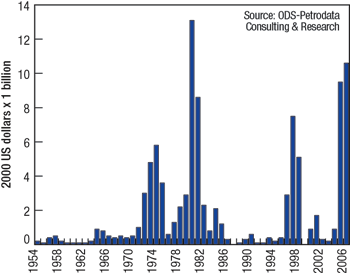 |
Fig. 5. Value of MODU orders, 1954 – 2006 year-to-date.
|
|
However, due to timing and other factors, this new construction will do little to relieve the rig shortage that has developed in the Gulf of Mexico. Most of these new rigs are not being built with the Gulf of Mexico in mind as the primary target market, and the bulk of these rigs will not enter service until 2008 or later.
The rigs on order or under construction include three tenders, eight drillships, 25 semisubmersibles and 60 jackups. The total value of the rigs on order as of early July 2006 was just over $24 billion, and the average cost by rig type gives some insight into the economics of different construction projects. The average cost of the jackups on order is $141.1 million, the average cost of the semis on order is $434.4 million, and the average cost of the drillships on shipyards’ current orderbooks is $566 million. The three tenders on order are being built at an average cost of $98 million.
Fifty-four of the jackups under construction were ordered on speculation, that is, without firm contract commitments in hand, while 17 of the 25 semis on order are speculative projects. Four of the eight drillships and two of the three tenders also were ordered on speculation. As of early July, five of the rigs currently on order or under construction that started off as speculative orders have landed contract commitments.
If all of these new construction projects remain on their announced schedules, seven new rigs will join the fleet in the second half of 2006, 24 new rigs will join the fleet in 2007 and 44 will join in 2008. Based on ODS-Petrodata’s current offshore rig demand forecasts, the industry will have little trouble absorbing the floating rigs that are under construction. However, the significant number of new additions to the jackup fleet may create a more competitive environment: 21 of the 24 rigs scheduled for delivery in 2007 are jackups, and 26 of the 44 rigs due out of yards in 2008 are jackups. While these new jackups should have little trouble securing work, jackup day rates in some rig market segments could soften as large numbers of new rigs enter the fleet. 
|
THE AUTHOR
|
| |
Tom Marsh serves as publisher - U.S.A. for ODS-Petrodata. He joined ODS-Petrodata predecessor Offshore Data Services in 1987, and has since served in a variety of editorial and research roles. Prior to joining Offshore Data Services, he worked for over five years as a marine surveyor and claims adjuster with an international energy insurance adjuster, where his duties involved a wide variety of vessels engaged in offshore work around the world. He graduated from Texas A&M University’s Texas Maritime Academy in 1980 with a Bachelor of Science degree in Marine Transportation and an unlimited U.S. Coast Guard Merchant Mariners license as Third Mate. After graduating, he sailed as Third Mate through the International Organization of Masters, Mates and Pilots.
|
|
|







